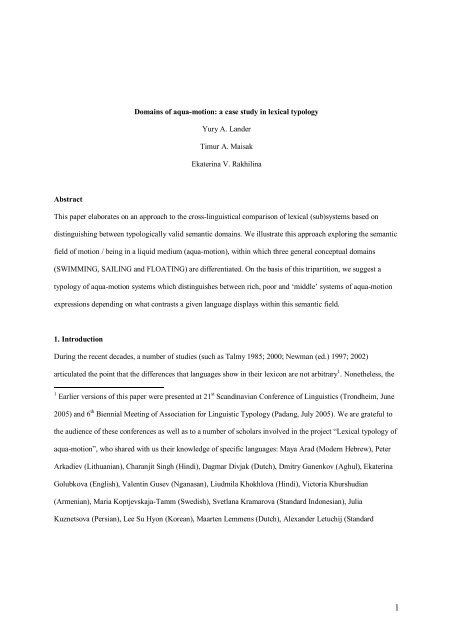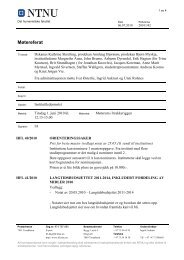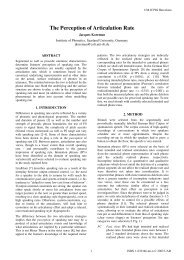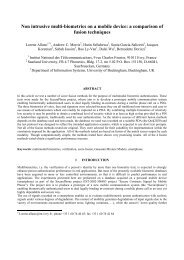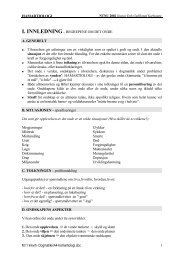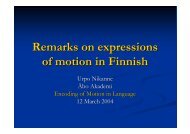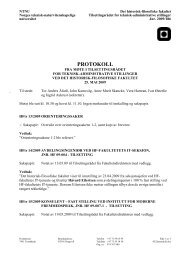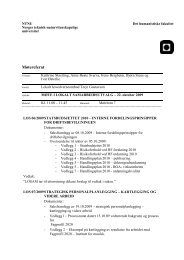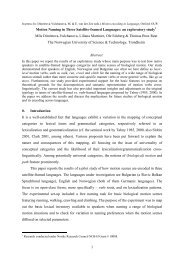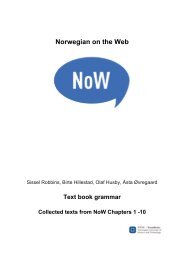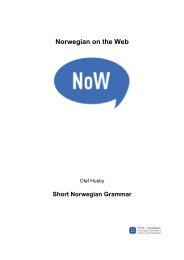Domains of aqua-motion: a case study in lexical typology Yury A ...
Domains of aqua-motion: a case study in lexical typology Yury A ...
Domains of aqua-motion: a case study in lexical typology Yury A ...
Create successful ePaper yourself
Turn your PDF publications into a flip-book with our unique Google optimized e-Paper software.
<strong>Doma<strong>in</strong>s</strong> <strong>of</strong> <strong>aqua</strong>-<strong>motion</strong>: a <strong>case</strong> <strong>study</strong> <strong>in</strong> <strong>lexical</strong> <strong>typology</strong><br />
<strong>Yury</strong> A. Lander<br />
Timur A. Maisak<br />
Ekater<strong>in</strong>a V. Rakhil<strong>in</strong>a<br />
Abstract<br />
This paper elaborates on an approach to the cross-l<strong>in</strong>guistical comparison <strong>of</strong> <strong>lexical</strong> (sub)systems based on<br />
dist<strong>in</strong>guish<strong>in</strong>g between typologically valid semantic doma<strong>in</strong>s. We illustrate this approach explor<strong>in</strong>g the semantic<br />
field <strong>of</strong> <strong>motion</strong> / be<strong>in</strong>g <strong>in</strong> a liquid medium (<strong>aqua</strong>-<strong>motion</strong>), with<strong>in</strong> which three general conceptual doma<strong>in</strong>s<br />
(SWIMMING, SAILING and FLOATING) are differentiated. On the basis <strong>of</strong> this tripartition, we suggest a<br />
<strong>typology</strong> <strong>of</strong> <strong>aqua</strong>-<strong>motion</strong> systems which dist<strong>in</strong>guishes between rich, poor and ‘middle’ systems <strong>of</strong> <strong>aqua</strong>-<strong>motion</strong><br />
expressions depend<strong>in</strong>g on what contrasts a given language displays with<strong>in</strong> this semantic field.<br />
1. Introduction<br />
Dur<strong>in</strong>g the recent decades, a number <strong>of</strong> studies (such as Talmy 1985; 2000; Newman (ed.) 1997; 2002)<br />
articulated the po<strong>in</strong>t that the differences that languages show <strong>in</strong> their lexicon are not arbitrary 1 . Nonetheless, the<br />
1 Earlier versions <strong>of</strong> this paper were presented at 21 st Scand<strong>in</strong>avian Conference <strong>of</strong> L<strong>in</strong>guistics (Trondheim, June<br />
2005) and 6 th Biennial Meet<strong>in</strong>g <strong>of</strong> Association for L<strong>in</strong>guistic Typology (Padang, July 2005). We are grateful to<br />
the audience <strong>of</strong> these conferences as well as to a number <strong>of</strong> scholars <strong>in</strong>volved <strong>in</strong> the project “Lexical <strong>typology</strong> <strong>of</strong><br />
<strong>aqua</strong>-<strong>motion</strong>”, who shared with us their knowledge <strong>of</strong> specific languages: Maya Arad (Modern Hebrew), Peter<br />
Arkadiev (Lithuanian), Charanjit S<strong>in</strong>gh (H<strong>in</strong>di), Dagmar Divjak (Dutch), Dmitry Ganenkov (Aghul), Ekater<strong>in</strong>a<br />
Golubkova (English), Valent<strong>in</strong> Gusev (Nganasan), Liudmila Khokhlova (H<strong>in</strong>di), Victoria Khurshudian<br />
(Armenian), Maria Koptjevskaja-Tamm (Swedish), Svetlana Kramarova (Standard Indonesian), Julia<br />
Kuznetsova (Persian), Lee Su Hyon (Korean), Maarten Lemmens (Dutch), Alexander Letuchij (Standard<br />
1
methodology <strong>of</strong> cross-l<strong>in</strong>guistic comparison <strong>of</strong> lexicon rema<strong>in</strong>s far from be<strong>in</strong>g well-established. In this paper, we<br />
elaborate on an approach to this which is related to the dist<strong>in</strong>guish<strong>in</strong>g between typologically valid semantic<br />
doma<strong>in</strong>s with<strong>in</strong> a concrete semantic field. In particular, we will exam<strong>in</strong>e the semantic field <strong>of</strong> <strong>motion</strong> / be<strong>in</strong>g <strong>in</strong><br />
liquid medium, called <strong>aqua</strong>-<strong>motion</strong> henceforth (we owe this term to Philippe Bourd<strong>in</strong>), and propose that with<strong>in</strong><br />
it three ma<strong>in</strong> doma<strong>in</strong>s can be recognized. These doma<strong>in</strong>s, as we will show, can be taken as basis for the<br />
comparison <strong>of</strong> this fragment <strong>of</strong> lexicon <strong>in</strong> different languages. 2<br />
Aqua-<strong>motion</strong> seems to be to be a relatively simple semantic field. Similarly to other verbs <strong>of</strong> <strong>motion</strong>,<br />
the verbs discussed here at first glance enable a rather small number <strong>of</strong> <strong>lexical</strong> parameters. Leav<strong>in</strong>g aside the<br />
Path, which follows rules that are seem<strong>in</strong>gly more or less well-described (see Fillmore 1983; 1997 and Talmy<br />
1985 among many others), these parameters are determ<strong>in</strong>ed by two basic participants only, namely the Figure<br />
and the Ground. Despite this, languages appear to exhibit a great deal <strong>of</strong> variation <strong>in</strong> the ways they express <strong>aqua</strong><strong>motion</strong><br />
concepts. For <strong>in</strong>stance, we observe that while English possesses no less than four basic <strong>aqua</strong>-<strong>motion</strong><br />
verbs (swim, sail, float, drift), there are languages such as Turkish, which have only one verb <strong>of</strong> this k<strong>in</strong>d, and<br />
also languages such as Indonesian, where the number <strong>of</strong> <strong>aqua</strong>-<strong>motion</strong> verbs is rather large. This diversity may be<br />
depicted as a k<strong>in</strong>d <strong>of</strong> variation <strong>in</strong> <strong>lexical</strong> (sub)systems (a more precise def<strong>in</strong>ition <strong>of</strong> this latter notion <strong>in</strong> relation<br />
to the topic <strong>of</strong> this paper will be given below).<br />
But where does this diversity come from? How can we systematize it and which parameters <strong>of</strong> cross-<br />
Arabic), Solmaz Merdanova (Aghul), Arto Mustajoki (F<strong>in</strong>nish), Anna Pan<strong>in</strong>a (Japanese), Ekater<strong>in</strong>a Protassova<br />
(F<strong>in</strong>nish), Olga Shemanaeva (German), Anna Smirnitskaja (Tamil), Natalia Vostrikova (Komi), Valent<strong>in</strong> Vydr<strong>in</strong><br />
(Man<strong>in</strong>ka). Special thanks are due to Mila Dimitrova-Vulchanova for her valuable comments. All errors are<br />
ours. This work was supported by RGNF (Russian Foundation for Basic Research) under grant No. 05-06-<br />
80400.<br />
2 For the reasons <strong>of</strong> space, we restrict our exposition to the explication <strong>of</strong> basic po<strong>in</strong>ts, provid<strong>in</strong>g a m<strong>in</strong>imum <strong>of</strong><br />
examples only. A more detailed discussion can be found <strong>in</strong> Maisak and Rakhil<strong>in</strong>a 2007.<br />
2
l<strong>in</strong>guistic variation should we consider? The problems posed by these questions can be approached <strong>in</strong> two ways.<br />
First, the relevant semantic parameters can be formulated deductively, start<strong>in</strong>g from our knowledge <strong>of</strong> the<br />
situation <strong>of</strong> <strong>aqua</strong>-<strong>motion</strong>. Second, it may be possible to establish tertium comparationis <strong>in</strong>ductively, look<strong>in</strong>g at<br />
the most frequent (or even universal) conceptual dist<strong>in</strong>ctions found <strong>in</strong> languages. Below we will follow the latter<br />
approach, the more so as parameters with<strong>in</strong> the <strong>aqua</strong>-<strong>motion</strong> field by no means seem apparent to us.<br />
The conclusions presented <strong>in</strong> this paper are based on the material collected with<strong>in</strong> a special project,<br />
which <strong>in</strong>volved scholars <strong>of</strong> various languages. 3 On the whole, we got the relevant <strong>in</strong>formation on more than forty<br />
languages (see Appendix). Although not fully representative, our sample presumably can give at least the first<br />
impression on how languages differ <strong>in</strong> the expression <strong>of</strong> <strong>aqua</strong>-<strong>motion</strong>.<br />
The rest <strong>of</strong> the paper is structured as follows. Section 2 <strong>in</strong>troduces the basic semantic doma<strong>in</strong>s <strong>of</strong> <strong>aqua</strong><strong>motion</strong><br />
and illustrates how the proposed dist<strong>in</strong>ction works with the description <strong>of</strong> <strong>aqua</strong>-<strong>motion</strong> expressions <strong>in</strong> a<br />
language with a quite extensive <strong>in</strong>ventory <strong>of</strong> the verbs dedicated to <strong>aqua</strong>-<strong>motion</strong>, namely <strong>in</strong> Standard Indonesian.<br />
Us<strong>in</strong>g the concepts provided by these doma<strong>in</strong>s, <strong>in</strong> Sections 3-5 we outl<strong>in</strong>e the diversity shown by the languages<br />
<strong>of</strong> our sample <strong>in</strong> respect <strong>of</strong> the expression <strong>of</strong> <strong>aqua</strong>-<strong>motion</strong>. Section 6 discusses certa<strong>in</strong> complexities that may<br />
arise with<strong>in</strong> our framework. The last section presents conclusions and perspectives on further research <strong>in</strong> the<br />
field.<br />
2. Semantic doma<strong>in</strong>s <strong>of</strong> <strong>aqua</strong>-<strong>motion</strong><br />
The most basic dist<strong>in</strong>ction that we propose is that between the semantic doma<strong>in</strong>s <strong>of</strong> SWIMMING, SAILING and<br />
FLOATING. This dist<strong>in</strong>ction manifests itself <strong>in</strong> most languages <strong>of</strong> our sample more or less consistently, be<strong>in</strong>g<br />
reflected either <strong>in</strong> <strong>lexical</strong> oppositions or <strong>in</strong> constra<strong>in</strong>ts on <strong>in</strong>terpretation aris<strong>in</strong>g <strong>in</strong> contexts related to <strong>aqua</strong><strong>motion</strong>.<br />
At the same time, it is perhaps the most abstract dist<strong>in</strong>ction <strong>of</strong> its k<strong>in</strong>d, s<strong>in</strong>ce it is def<strong>in</strong>itely based on<br />
3 Detailed studies <strong>of</strong> the expressions <strong>of</strong> <strong>aqua</strong>-<strong>motion</strong> <strong>in</strong> many <strong>of</strong> these languages are now published <strong>in</strong> Maisak<br />
and Rakhil<strong>in</strong>a (eds) 2007.<br />
3
certa<strong>in</strong> prototypes and allows deviations from them. Let us beg<strong>in</strong> with the <strong>in</strong>formal <strong>in</strong>troduction <strong>of</strong> these<br />
prototypes.<br />
The SWIMMING doma<strong>in</strong> is associated with self-propelled <strong>motion</strong> <strong>of</strong> an animate Figure. Naturally,<br />
SWIMMING verbs presuppose much control and agentivity and are the default expressions <strong>of</strong> <strong>aqua</strong>-<strong>motion</strong> at<br />
least for humans, certa<strong>in</strong> animals and fish (but see Section 6 for a special status <strong>of</strong> fish schools <strong>in</strong> this respect)..<br />
SAILING verbs refer to <strong>motion</strong> <strong>of</strong> vessels or people aboard. The situation denoted by verbs <strong>of</strong> this k<strong>in</strong>d<br />
also has a flavor <strong>of</strong> agentivity, yet this is not always the agentivity <strong>of</strong> the Figure, s<strong>in</strong>ce examples like (1)<br />
represent this doma<strong>in</strong> as well 4 :<br />
(1) But his seamanship skills were legendary; many <strong>of</strong> the passengers sailed on the Titanic because<br />
Capta<strong>in</strong> Smith was <strong>in</strong> charge.<br />
An <strong>in</strong>terest<strong>in</strong>g feature <strong>of</strong> many (but not all) SAILING verbs is their capacity to be used both with animate,<br />
ma<strong>in</strong>ly human, and <strong>in</strong>animate Figures, namely vessels. This could be thought <strong>of</strong> as an <strong>in</strong>stance <strong>of</strong> the wellknown<br />
metonymical shift CONTAINER > CONTENTS. However, the wide occurrence <strong>of</strong> such<br />
polyfunctionality makes us consider it an important and partly constitut<strong>in</strong>g feature <strong>of</strong> the SAILING doma<strong>in</strong>.<br />
The FLOATING doma<strong>in</strong> reflects the situations <strong>of</strong> ‘passive’, uncontrolled and non-agentive <strong>aqua</strong>-<strong>motion</strong><br />
(not necessarily float<strong>in</strong>g per se). Therefore it is FLOATING verbs that are commonly used with <strong>in</strong>animate<br />
Figures. Notably some <strong>of</strong> the situations covered by this doma<strong>in</strong> are even not necessarily associated with <strong>motion</strong><br />
proper, but nevertheless are expressed with <strong>aqua</strong>-<strong>motion</strong> verbs <strong>in</strong> many languages and consequently can be also<br />
attributed to the <strong>aqua</strong>-<strong>motion</strong> semantic field; cf. the follow<strong>in</strong>g example from Modern Hebrew (the English<br />
translation with the verb float can also serve as an example <strong>of</strong> this k<strong>in</strong>d):<br />
4 In fact, SAILING verbs may differ <strong>in</strong> whether they allow such contexts, but the most neutral <strong>of</strong> them normally<br />
do so.<br />
4
(2) Ha gezer caf ba marak.<br />
The carrot floated <strong>in</strong> the soup.<br />
We will now illustrate the proposed tripartition with data from a language whose <strong>aqua</strong>-<strong>motion</strong> lexicon is<br />
significantly dist<strong>in</strong>ct and more complex than, say, that <strong>of</strong> English, namely <strong>in</strong> (Standard) Indonesian. 5 This<br />
language has a great number <strong>of</strong> verbs relevant to our topic. Some <strong>of</strong> them have rather restricted distribution,<br />
others are more common. But despite their diversity, Indonesian <strong>aqua</strong>-<strong>motion</strong> verbs can be easily classified <strong>in</strong>to<br />
three ma<strong>in</strong> groups that correspond to the doma<strong>in</strong>s dist<strong>in</strong>guished above, as is reflected <strong>in</strong> Table 1. The criteria<br />
accord<strong>in</strong>g to which these groups are dist<strong>in</strong>guished are ma<strong>in</strong>ly semantic and <strong>in</strong>clude agentivity and control,<br />
constra<strong>in</strong>ts on the onthological status <strong>of</strong> the Figure, the presence / absence <strong>of</strong> <strong>in</strong>terpretations related to<br />
directedness, as well as certa<strong>in</strong> aspectual characteristics; see Lander and Kramarova 2007 for details.<br />
5 Standard Indonesian is a variety <strong>of</strong> Malay which is used as the <strong>of</strong>ficial language <strong>of</strong> Republic <strong>of</strong> Indonesia. As<br />
we will note <strong>in</strong> Section 6, some other Malay varieties have considerably different systems <strong>of</strong> <strong>aqua</strong>-<strong>motion</strong><br />
expressions.<br />
5
Table 1. Standard Indonesian <strong>aqua</strong>-<strong>motion</strong> verbs.<br />
SWIMMING SAILING FLOATING<br />
Neutral<br />
renang-verbs (berenang,<br />
merenangi) ‘swim (<strong>in</strong>)’<br />
Specified<br />
menyelam ‘plunge, swim under the<br />
water’<br />
Neutral<br />
berlayar, melayari ‘sail’<br />
Means-specified<br />
berkapal ‘sail on a ship’<br />
berperahu ‘sail on a boat’<br />
berakit ‘sail on a raft’<br />
berkayuh, berdayung ‘row’<br />
Place-specified<br />
mendanau ‘go <strong>in</strong> a lake’<br />
melaut ‘go seaward’<br />
menyelat ‘go <strong>in</strong> a channell’<br />
Strong dynamic<br />
hanyut ‘float (with the current)’<br />
Semi-dynamic<br />
apung-verbs (terapung,<br />
mengapung) ‘float’<br />
ambang-verbs (terambang,<br />
mengambang) ‘float’<br />
terombang-amb<strong>in</strong>g ‘drift about (on<br />
water), sw<strong>in</strong>g to and fro’<br />
For example, the verbs derived from the root renang normally can only refer to controlled situations<br />
with animate Figures and presuppose the absence <strong>of</strong> “assistant means” for hold<strong>in</strong>g the Figure on the surface: 6<br />
(3) Paus abu-abu jarang ter-lihat berenang h<strong>in</strong>gga ke darat.<br />
whale grey rarely APASS-see swim up.to to land<br />
‘Grey whales are rarely observed to swim up to the land.’<br />
6 Abbreviations used <strong>in</strong> the morphological gloss<strong>in</strong>g l<strong>in</strong>e are ACT – active voice, APASS – accidental passive, ART –<br />
article, CONT – cont<strong>in</strong>uous, DAT – dative, DEF – def<strong>in</strong>ite, ERG – ergative, EXCL – exclusive, EZ – ezafe marker, F –<br />
fem<strong>in</strong><strong>in</strong>e, GEN – genitive, IPF – imperfective, LAT – lative, NOM – nom<strong>in</strong>ative, PL – plural, POST – posterior<br />
localization, PRS – present, RFL – reflexive, SG – s<strong>in</strong>gular, ST – stative participle.<br />
6
Similarly, menyelam ‘swim under the water; dive’ presupposes control and is used almost exclusively with<br />
animates (the only exception be<strong>in</strong>g its use with submar<strong>in</strong>es). Essentially, these restrictions set the renang-verbs<br />
and menyelam apart from other AQUA-<strong>motion</strong> verbs, so we may conclude that these lexemes constitute the<br />
SWIMMING doma<strong>in</strong> <strong>in</strong> Indonesian.<br />
The SAILING doma<strong>in</strong> <strong>in</strong> Indonesian is quite rich, although all verbs belong<strong>in</strong>g to it are derived from<br />
nom<strong>in</strong>al roots which describe either means or place. All SAILING verbs can denote the <strong>motion</strong> <strong>of</strong> a person<br />
aboard a vessel, and almost all <strong>of</strong> them – with the exception <strong>of</strong> verbs specify<strong>in</strong>g the means – can refer to the<br />
<strong>motion</strong> <strong>of</strong> vessels. Some means-specified verbs (e.g., berakit ‘sail on a raft’ <strong>in</strong> (4)) show a further peculiarity:<br />
they require their Figure to control the vessel (and not simply to be a passenger, like <strong>in</strong> (1) above). This subclass<br />
<strong>of</strong> verbs may be less prototypical for the SAILING doma<strong>in</strong>.<br />
(4) Abang saya berakit ke s<strong>in</strong>i.<br />
big.brother I sail.on.a.raft to here<br />
‘My big brother sails here driv<strong>in</strong>g a raft.’<br />
Still, on the whole, the verbs that are thought here to form the SAILING class share a number <strong>of</strong> semantic<br />
features that dist<strong>in</strong>guish them from SWIMMING verbs and from verbs <strong>of</strong> the FLOATING doma<strong>in</strong> to be<br />
discussed below.<br />
Indonesian possesses a number <strong>of</strong> <strong>aqua</strong>-<strong>motion</strong> words that allow for Figures <strong>of</strong> almost any k<strong>in</strong>d. A<br />
common feature <strong>of</strong> these verbs, which constitute the FLOATING doma<strong>in</strong> <strong>in</strong> our scheme, is that they usually<br />
describe situations that do not presuppose any control and sometimes even imply its absence. 7 Actually, there are<br />
good reasons to dist<strong>in</strong>guish between the verbs that usually denote uncontrolled situations and the verbs that<br />
7 Curiously, some <strong>of</strong> these verbs conta<strong>in</strong> the prefix ter-, which explicitly marks the absence <strong>of</strong> control.<br />
7
necessarily do so. The first subclass <strong>in</strong>volv<strong>in</strong>g the verbs derived from the roots apung and ambang may be used<br />
even when the situation allows for a controlled read<strong>in</strong>g, yet the control component is somehow obscured or<br />
graded, as <strong>in</strong> (5). In this example, though the float<strong>in</strong>g <strong>of</strong> the ship is apparently controlled, what is pr<strong>of</strong>iled (<strong>in</strong> the<br />
sense <strong>of</strong> Langacker 1987) is only the fact that it rema<strong>in</strong>s on the surface and does not s<strong>in</strong>k. Note that <strong>in</strong> (6) (taken<br />
from a story <strong>of</strong> persons hav<strong>in</strong>g suffered a shipwreck) the use <strong>of</strong> the same verb is def<strong>in</strong>itely motivated by the wish<br />
to emphasize the absence <strong>of</strong> control.<br />
(5) para awak bekerja keras untuk men-jaga agar kapal […] tetap terapung.<br />
crew work hard for ACT-watch.over so.as.to ship permanently float<br />
‘...the crew worked hard watch<strong>in</strong>g over so as to the ship floated.’<br />
(6) Selama satu malam kami terapung di tengah laut […]<br />
dur<strong>in</strong>g one night we:EXCL float <strong>in</strong> middle sea<br />
‘We were float<strong>in</strong>g dur<strong>in</strong>g one night <strong>in</strong> the middle <strong>of</strong> the sea…’<br />
The second subclass that consists at least <strong>of</strong> the verb hanyut ‘float (with the current)’ (and possibly also<br />
terombang-amb<strong>in</strong>g ‘drift about (on water)’) always <strong>in</strong>dicates the absence <strong>of</strong> control. This is vividly demonstrated<br />
by the expression merenangkan yang hanyut ‘to save a drown<strong>in</strong>g person’, where the causative verb<br />
merenangkan (lit. ‘to make one swim’, derived from the SWIMMING root renang) is clearly contrasted with<br />
hanyut. It is also worth not<strong>in</strong>g that it is hanyut that typically is used when the <strong>aqua</strong>-<strong>motion</strong> <strong>of</strong> a Figure is strongly<br />
dynamic and driven by the directed current:<br />
(7) Puluhan batu gunung dan potongan kayu hanyut ter-bawa arus<br />
dozen stone mounta<strong>in</strong> and piece wood float.with.the.current APASS-carry current<br />
8
sungai yang<br />
bergejolak.<br />
river REL flare.up<br />
‘Dozens <strong>of</strong> mounta<strong>in</strong> stones and pieces <strong>of</strong> wood were carried by the current <strong>of</strong> the grow<strong>in</strong>g river.’<br />
F<strong>in</strong>ally, <strong>in</strong> some <strong>aqua</strong>-<strong>motion</strong> contexts Indonesian can employ general verbs <strong>of</strong> <strong>motion</strong> (for <strong>motion</strong> <strong>of</strong><br />
ships and other large Figures) and verbs <strong>of</strong> existence/location. We will return to this below.<br />
Summ<strong>in</strong>g up this section, there are good reasons to dist<strong>in</strong>guish between the doma<strong>in</strong>s <strong>of</strong> SWIMMING,<br />
SAILING and FLOATING with<strong>in</strong> the semantic field <strong>of</strong> <strong>aqua</strong>-<strong>motion</strong>. Importantly, this dist<strong>in</strong>ction is not based<br />
exclusively on English data and manifests itself as well <strong>in</strong> languages with more complex systems <strong>of</strong> <strong>aqua</strong>-<strong>motion</strong><br />
expressions such as Indonesian. Given this, it makes sense to assume this tripartition as a possible basis for the<br />
<strong>typology</strong> <strong>of</strong> <strong>aqua</strong>-<strong>motion</strong> expressions. Such a <strong>typology</strong> may look as a <strong>typology</strong> <strong>of</strong> <strong>aqua</strong>-<strong>motion</strong> systems, which<br />
at this stage can be def<strong>in</strong>ed as types <strong>of</strong> correlations <strong>of</strong> semantic doma<strong>in</strong>s with their <strong>lexical</strong> representations. In the<br />
follow<strong>in</strong>g sections we will contrast between three k<strong>in</strong>ds <strong>of</strong> <strong>aqua</strong>-<strong>motion</strong> systems, which we call ‘middle’<br />
systems, rich systems and poor systems.<br />
3. ‘Middle’ systems<br />
We charachterize an <strong>aqua</strong>-<strong>motion</strong> system ‘middle’ if it dist<strong>in</strong>guishes between SWIMMING, SAILING and<br />
FLOATING, but does not display any additional oppositions. Essentially, such systems do not constitute the<br />
majority. In our sample, there are only three languages <strong>of</strong> this k<strong>in</strong>d, among which two (Persian and Tamil)<br />
belong to the same area but one (Man<strong>in</strong>ka) is spoken <strong>in</strong> a rather different region, namely <strong>in</strong> Western Africa.<br />
All <strong>of</strong> these languages have dist<strong>in</strong>ct <strong>lexical</strong> items for SWIMMING and FLOATING. This is illustrated<br />
<strong>in</strong> (8) and (9) by Man<strong>in</strong>ka examples:<br />
9
(8) DýØkuØ-deØnnián-nuØ yeÉ aØluÉ naÉmuÉn-naÉ aØluÉ ØnaÉ kýÉ.<br />
duck-child-PL IPF RFL swim-IPF RFL mother after<br />
‘The duckl<strong>in</strong>gs are swimm<strong>in</strong>g after their mother.’<br />
(9) Yiáriá kuÉduÉn` fuÉn-nián jiá` kaØn.<br />
wood piece-ART float-ST water-ART on<br />
‘A piece <strong>of</strong> wood is float<strong>in</strong>g <strong>in</strong> the water.’<br />
But for the SAILING doma<strong>in</strong> all <strong>of</strong> the languages with ‘middle’ systems for which we have enough data<br />
use general verbs <strong>of</strong> <strong>motion</strong>; cf. (10), aga<strong>in</strong> from Man<strong>in</strong>ka:<br />
(10) KuÉluÉn` yeÉ naÝ kaØn baÉ kaÉnkuÉn` maØ.<br />
boat-ART IMF come CONT river bank-ART to<br />
‘A boat is sail<strong>in</strong>g towards (lit. comes to) the bank <strong>of</strong> the river.’<br />
This is not likely to be just a co<strong>in</strong>cidence. Thus, recall that <strong>in</strong> Indonesian too the general verbs <strong>of</strong> <strong>motion</strong><br />
such as ‘go’ and ‘move’ can be used <strong>in</strong> the expressions <strong>of</strong> <strong>aqua</strong>-<strong>motion</strong>, and <strong>in</strong> fact, the preferable doma<strong>in</strong> for<br />
them is exactly the doma<strong>in</strong> <strong>of</strong> SAILING. It can be suggested therefore that <strong>in</strong> Persian, Tamil and Man<strong>in</strong>ka we<br />
observe the same phenomenon. The only difference <strong>of</strong> these languages from Indonesian is that their systems lack<br />
additional contrasts, although general verbs <strong>of</strong> <strong>motion</strong> cover<strong>in</strong>g the SAILING doma<strong>in</strong> do contrast this doma<strong>in</strong> to<br />
the other two. 8 Noteworthy, <strong>in</strong> many languages, dedicated SAILING verbs are derived from nouns (like ‘sail’ or<br />
8 Curiously, <strong>in</strong> Armenian, whose system resembles ‘middle’ systems, general verbs <strong>of</strong> <strong>motion</strong> are used ma<strong>in</strong>ly <strong>in</strong><br />
the FLOATING doma<strong>in</strong>, while both SWIMMING and SAILING employ specified verbs (resp. loγal and navel).<br />
Armenian is also <strong>in</strong>terest<strong>in</strong>g <strong>in</strong> that <strong>in</strong> this language the FLOATING doma<strong>in</strong> is partly covered by the<br />
SWIMMING verb.<br />
10
‘ship’), which possibly po<strong>in</strong>ts to the fact that they are not natives <strong>in</strong> <strong>aqua</strong>-<strong>motion</strong> systems. Nevertheless, the data<br />
<strong>of</strong> ‘middle’ systems shows that the absence <strong>of</strong> such verbs does not preclude the contrast between SAILING and<br />
other doma<strong>in</strong>s.<br />
4. Rich systems<br />
Rich <strong>aqua</strong>-<strong>motion</strong> systems also dist<strong>in</strong>guish between the three basic doma<strong>in</strong>s, but they show additional <strong>lexical</strong><br />
oppositions with<strong>in</strong> at least some <strong>of</strong> them. To be sure, languages may differ <strong>in</strong> which <strong>of</strong> the doma<strong>in</strong>s they<br />
elaborate and how many <strong>of</strong> them they elaborate (for example, Indonesian elaborates all the three). In what<br />
follows, we will focus on those <strong>of</strong> the contrasts observed <strong>in</strong> the SWIMMING, SAILING and FLOATING<br />
doma<strong>in</strong>s that seem most widespread or are <strong>of</strong> special theoretical <strong>in</strong>terest.<br />
The SWIMMING doma<strong>in</strong> usually does not show much complexity. Given the anthropocentric nature <strong>of</strong><br />
language together with the fact that human <strong>aqua</strong>-<strong>motion</strong> (just as any <strong>aqua</strong>-<strong>motion</strong> <strong>of</strong> agentive species) is<br />
associated with this doma<strong>in</strong> by default, one can expect to f<strong>in</strong>d here an opposition based on humanness. This<br />
expectation comes only partly true, however. Indeed there are languages with SWIMMING verbs seem<strong>in</strong>gly<br />
restricted to human Figures. Thus, the Komi root vartč- is used almost only for humans (and marg<strong>in</strong>ally for<br />
dogs). 9 A more specific <strong>case</strong> is represented by the Korean complex verb suyeng hata (lit. ‘swimm<strong>in</strong>g do’), the<br />
use <strong>of</strong> which is also restricted to humans, but ma<strong>in</strong>ly to those go<strong>in</strong>g <strong>in</strong>to sports. Notably, both languages also<br />
have neutral SWIMMING verbs that can be applied both for humans and other animates. It turns out therefore<br />
that the human/non-human opposition is much more peripheral with<strong>in</strong> the <strong>aqua</strong>-<strong>motion</strong> field than it <strong>of</strong>ten appears<br />
to be <strong>in</strong> other aspects <strong>of</strong> the language.<br />
The contrasts observed with<strong>in</strong> the SAILING doma<strong>in</strong> are also few, yet most <strong>of</strong>ten they are easily<br />
recognizable. Some <strong>of</strong> them, namely those related to the specification <strong>of</strong> the location and means, have been<br />
9 This may be a consequence <strong>of</strong> the fact that this verb is derived <strong>of</strong> a verb with the mean<strong>in</strong>g ‘kick’, which can not<br />
be applied to many <strong>of</strong> the swimm<strong>in</strong>g animals.<br />
11
already illustrated <strong>in</strong> Section 2 with the Indonesian data. Other examples <strong>of</strong> verbs <strong>in</strong>volv<strong>in</strong>g such specification<br />
<strong>in</strong>clude the Nganasan verb ŋəntə(u)- ‘sail on a wooden boat’, the Korean complex predicate hanghay hata ‘sail<br />
the sea’ (lit. ‘navigation do’) and the obsolete Portuguese verb marear ‘sail the sea’. Remarkably, a number <strong>of</strong><br />
languages have or seem to have had special verbs for sail<strong>in</strong>g proper, i.e. <strong>motion</strong> under sail. Sometimes – as <strong>in</strong><br />
English (and also <strong>in</strong> Indonesian, where the basic SAILING verb berlayar is derived from the noun layar ‘sail’) –<br />
these verbs have already obta<strong>in</strong>ed more or less neutral semantics. In other <strong>case</strong>s, however, they reta<strong>in</strong>ed their<br />
orig<strong>in</strong>al restrictions (thus, Portuguese velejar and Dutch zeilen can express <strong>motion</strong> under sail only). Anyway, we<br />
conclude that this k<strong>in</strong>d <strong>of</strong> <strong>motion</strong> tends to be conceptualized differently from other k<strong>in</strong>ds <strong>of</strong> SAILING, the more<br />
so as it is less associated with control and agentivity.<br />
As concerns the FLOATING doma<strong>in</strong>, the most apparent dist<strong>in</strong>ction found here is the one between the<br />
directed <strong>motion</strong> driven by current and the <strong>motion</strong> to and fro, without an established direction and possibly<br />
without real <strong>motion</strong> at all. Aga<strong>in</strong>, Indonesian has already provided an example <strong>of</strong> this dist<strong>in</strong>ction, but <strong>in</strong> reality it<br />
is by no means restricted to Indonesian. Japanese, for <strong>in</strong>stance, has at least four verbs <strong>of</strong> FLOATING: while<br />
nagareru denotes passive <strong>motion</strong> driven by current, tadayou describes passive <strong>motion</strong> <strong>in</strong> different directions (to<br />
and fro), and the quasi-synonymous pair uku / ukabu is associated with float<strong>in</strong>g up and be<strong>in</strong>g on the surface.<br />
With<strong>in</strong> the same doma<strong>in</strong>, an even clearer cut-<strong>of</strong>f l<strong>in</strong>e is found between “simple float<strong>in</strong>g” and ‘be<strong>in</strong>g <strong>in</strong><br />
conf<strong>in</strong>ed space’. The latter sometimes requires different expressions, which are almost always existential or<br />
locative verbs. Thus, consider the follow<strong>in</strong>g Arabic example:<br />
(11) t-u:ğad-u qit‘at-u khubz-<strong>in</strong> fi: al-ħasa’i.<br />
3F-be.located-SG piece-NOM bread-GEN <strong>in</strong> soup<br />
‘There is a piece <strong>of</strong> bread <strong>in</strong> the soup.’<br />
Crucially, Arabic does possess two specialized FLOATING verbs ‘a:ma (denot<strong>in</strong>g directed passive <strong>motion</strong>) and<br />
12
Tafa: (referr<strong>in</strong>g to float<strong>in</strong>g up and be<strong>in</strong>g on the surface), so the appearance <strong>of</strong> a locative verb <strong>in</strong> (11), which is by<br />
the way a perfect parallel to (2), may at first look surpris<strong>in</strong>g. Note, however, that such expressions as (11) are<br />
normally thetic. In fact, it is even not obvious whether the ‘subject’ serves as a Figure here, s<strong>in</strong>ce quite <strong>of</strong>ten<br />
such utterances characterize the conta<strong>in</strong>er <strong>in</strong> respect <strong>of</strong> its contents. Clearly, it is this that relates the subdoma<strong>in</strong><br />
<strong>of</strong> ‘be<strong>in</strong>g <strong>in</strong> conf<strong>in</strong>ed space’ to existential expressions, which are also thetic (Sasse 1987) and frequently<br />
characterize the location. Further, the semantic properties <strong>of</strong> this subdoma<strong>in</strong> apparently show too much<br />
deviations from any <strong>aqua</strong>-<strong>motion</strong> prototype, which can (albeit need not) be reflected by the choice <strong>of</strong> a non<strong>aqua</strong>-<strong>motion</strong><br />
verb.<br />
5. Poor systems<br />
In a poor <strong>aqua</strong>-<strong>motion</strong> system, the dist<strong>in</strong>ction between SWIMMING, SAILING and FLOATING is obscured or<br />
made peripheral. That is why such poor systems may at first seem challeng<strong>in</strong>g for our conception.<br />
A good example <strong>of</strong> a poor system is the one <strong>of</strong> many Slavic languages, where a s<strong>in</strong>gle root supplies all<br />
<strong>of</strong> the three doma<strong>in</strong>s. To cite one example, Russian has only a pair <strong>of</strong> specific <strong>aqua</strong>-<strong>motion</strong> verbs plyt’ and<br />
plavat’, which are morphologically related and differ roughly <strong>in</strong> the iterativity and/or directedness <strong>of</strong> the process<br />
irrespectively <strong>of</strong> the doma<strong>in</strong>; cf.:<br />
(12) a. Sportsmen / lodka / brevno plyvet k beregu.<br />
sportsman-NOM boat-NOM log-NOM swims/sails/floats towards bank-DAT<br />
‘A sportsman / boat / log is mov<strong>in</strong>g towards the bank.’<br />
b. Sportsmen / lodka / brevno plavaet nedaleko ot berega.<br />
sportsman-NOM boat-NOM log-NOM swims/sails/floats not.far from bank-GEN<br />
‘A sportsman / boat / log is mov<strong>in</strong>g (to and fro) not far from the bank.’<br />
13
Interest<strong>in</strong>gly, however, even <strong>in</strong> such languages one can frequently f<strong>in</strong>d more peripheral verbs associated<br />
with one <strong>of</strong> the three doma<strong>in</strong>s only. This is the <strong>case</strong>, for <strong>in</strong>stance, <strong>in</strong> Lithuanian, where the whole range <strong>of</strong> <strong>aqua</strong><strong>motion</strong><br />
contexts can be covered by the pair plaukti (directed) / plaukioti (non-directed), but with<strong>in</strong> the<br />
FLOATING doma<strong>in</strong> we observe several verbs that are used on a par with plaukioti (related plaukyti, plūduriuoti,<br />
and būti ‘be’). Similarly, the German verb schwimmen can operate <strong>in</strong> all three doma<strong>in</strong>s (13), yet there are also<br />
verbs like segeln ‘sail’, treiben ‘be carried by water’, driften ‘drift, float’ which are more peripheral but<br />
nevertheless restricted to some <strong>of</strong> the doma<strong>in</strong>s.<br />
(13) a. Im Aquarium schwimmen Goldfische.<br />
‘Goldfish are swimm<strong>in</strong>g <strong>in</strong> the <strong>aqua</strong>rium.’<br />
b. In der Ferne schwimmt e<strong>in</strong> Schiff.<br />
‘A ship is sail<strong>in</strong>g <strong>in</strong> the distance.’<br />
c. Nur tote Fische schwimmen mit dem Strom.<br />
‘Only dead fish are float<strong>in</strong>g with the stream.’<br />
Another type <strong>of</strong> poor system does not neutralize the dist<strong>in</strong>ctions between all <strong>of</strong> the doma<strong>in</strong>s <strong>of</strong> <strong>aqua</strong><strong>motion</strong>,<br />
but only contrasts one <strong>of</strong> them with the other two. Many examples <strong>of</strong> this type are found <strong>in</strong> some North<br />
Caucasian languages <strong>of</strong> Daghestan, which do not possess ord<strong>in</strong>ary <strong>aqua</strong>-<strong>motion</strong> verbs at all and most <strong>of</strong>ten<br />
employ general verbs <strong>of</strong> <strong>motion</strong> and location for the description <strong>of</strong> this semantic field. However, <strong>in</strong> the<br />
SWIMMING doma<strong>in</strong> we do observe certa<strong>in</strong> specified expressions <strong>of</strong> <strong>aqua</strong>-<strong>motion</strong> which are essentially complex<br />
predicates; cf. (14) from Aghul:<br />
14
(14) gadaji lepe q’-a-a nac’u-n q:ireRi-q-t:i.<br />
boy:ERG wave do-IPF-PRS river-GEN edge-POST-LAT<br />
‘A boy is swimm<strong>in</strong>g (lit. mak<strong>in</strong>g a wave) towards the river’s bank.’<br />
In other languages <strong>of</strong> the area, the same sense can be conveyed by similar complexes such as ‘do/beat water’,<br />
‘take out river/water’, ‘do swimm<strong>in</strong>g’, where the word for ‘swimm<strong>in</strong>g’ is <strong>of</strong>ten borrowed.<br />
All <strong>in</strong> all, the data from languages with poor <strong>aqua</strong>-<strong>motion</strong> systems demonstrates that even these<br />
languages do tend to dist<strong>in</strong>guish between the doma<strong>in</strong>s <strong>of</strong> SWIMMING, SAILING and FLOATING. Despite the<br />
fact that such languages have s<strong>in</strong>gle verbs used for all k<strong>in</strong>ds <strong>of</strong> <strong>aqua</strong>-<strong>motion</strong>, not <strong>in</strong>frequently they recruit other<br />
means, either <strong>lexical</strong> or at least partly compositional, for separat<strong>in</strong>g some doma<strong>in</strong>s from the others.<br />
6. Shifts and extensions<br />
So far we presented the doma<strong>in</strong>s <strong>of</strong> <strong>aqua</strong>-<strong>motion</strong> as easily determ<strong>in</strong>able. In this section, however, we would like<br />
to discuss a few difficulties that can be met while describ<strong>in</strong>g this semantic field <strong>in</strong> terms <strong>of</strong> the doma<strong>in</strong>s <strong>of</strong><br />
SWIMMING, SAILING and FLOATING.<br />
The ma<strong>in</strong> problem with our approach relates to the fact that these semantic doma<strong>in</strong>s are themselves not<br />
homogeneous. Each <strong>of</strong> them has a semantic prototype, but languages easily allow deviations from them. Such<br />
deviat<strong>in</strong>g <strong>aqua</strong>-<strong>motion</strong> verbs lack certa<strong>in</strong> properties <strong>of</strong> a prototype but nevertheless are conceptualized as<br />
belong<strong>in</strong>g to a given doma<strong>in</strong>. Moreover, the existence <strong>of</strong> such deviations leads to the fuzz<strong>in</strong>ess <strong>of</strong> borderl<strong>in</strong>es<br />
between different doma<strong>in</strong>s whence a given context may be conceptualized as belong<strong>in</strong>g to one doma<strong>in</strong> <strong>in</strong> some<br />
languages, yet to a different doma<strong>in</strong> <strong>in</strong> some others. As a result, occasionally we can observe the extension <strong>of</strong> a<br />
doma<strong>in</strong> at the expense <strong>of</strong> another one. In addition, the use <strong>of</strong> verbs <strong>in</strong> “deviat<strong>in</strong>g” contexts can conduce to their<br />
re-conceptualization, that is to the mean<strong>in</strong>g shift.<br />
Thus, despite the fact that the controlled <strong>motion</strong> <strong>of</strong> animate Figures is associated with SWIMMING,<br />
15
certa<strong>in</strong> animates turn out to be ‘less swimm<strong>in</strong>g’ than others. While <strong>in</strong>dividual species <strong>of</strong> fish are usually thought<br />
to swim, the <strong>motion</strong> <strong>of</strong> groups and schools <strong>of</strong> fish is <strong>of</strong>ten expressed by general verbs <strong>of</strong> <strong>motion</strong>. This is<br />
observed, <strong>in</strong> particular, <strong>in</strong> Russian and Persian. The follow<strong>in</strong>g example from the latter also illustrates the fact that<br />
the Persian SWIMMING verb (šenā kardan, lit. ‘swimm<strong>in</strong>g do’) is <strong>in</strong>felicitous <strong>in</strong> such context:<br />
(15) daste-ye māhi be toxmrizi mi-rav-ad // *šenā mi-kon-ad.<br />
school-EZ fish to spawn<strong>in</strong>g PRS-go-3SG swimm<strong>in</strong>g PRS-do-3SG<br />
‘A school <strong>of</strong> fish goes to breed.’<br />
Similarly, the <strong>motion</strong> <strong>of</strong> birds <strong>in</strong> water seems to be considered less agentive than that <strong>of</strong> the Figure <strong>in</strong> the<br />
prototypical SWIMMING contexts and sometimes is covered by FLOATING verbs. For example, <strong>in</strong> Arabic, the<br />
<strong>aqua</strong>-<strong>motion</strong> <strong>of</strong> water birds can be expressed by the verb ‘a:ma, which applies usually to objects carried by water<br />
(albeit the SWIMMING verb sabaħa used for humans, fish, animals etc. is also possible <strong>in</strong> this context):<br />
(16) a. ta-‘u:m-u / ta-sbaħ-u baTT-a:t-un saγi:r-at-un khalfa ’umm-i-γim.<br />
3F-float-SG 3F-swim-SG duck-PL-NOM small-F-NOM after mother-GEN-3PL<br />
‘The duckl<strong>in</strong>gs are swimm<strong>in</strong>g after their mother.’<br />
b. qita‘-u as-salğ-i ta-‘u:m-u fawqa SaTħ-i al-ma:’-i.<br />
piece.PL-NOM DEF-ice-GEN 3F-float.PRS-SG above surface-GEN DEF-water-GEN<br />
‘There are pieces <strong>of</strong> ice float<strong>in</strong>g on the surface <strong>of</strong> the water.’<br />
A similar, yet more complicated situation is found <strong>in</strong> related Hebrew, where birds also normally come together<br />
with certa<strong>in</strong> float<strong>in</strong>g objects such as icebergs, be<strong>in</strong>g covered by the root šat. However, while this root orig<strong>in</strong>ally<br />
belonged to the FLOATING doma<strong>in</strong>, now it is used for the SAILING doma<strong>in</strong> as well, so its relation to the lack<br />
16
<strong>of</strong> agentivity is lost or at least weakened. Instead, this root turns to be associated with a more abstract idea <strong>of</strong><br />
<strong>aqua</strong>-<strong>motion</strong> without visible effort, a sort <strong>of</strong> ‘glid<strong>in</strong>g’ on a surface.<br />
This last <strong>case</strong> illustrates also the possibility <strong>of</strong> the semantic shift due to the fuzz<strong>in</strong>ess <strong>of</strong> the features<br />
govern<strong>in</strong>g the assignment <strong>of</strong> a verb to a concrete doma<strong>in</strong>. An even more dramatic shift evidently has occurred<br />
with the Russian verb pair plyt’ and plavat’ mentioned <strong>in</strong> the previous section (see Makeeva and Rakhil<strong>in</strong>a 2004<br />
for details). In Old Russian, these verbs were seem<strong>in</strong>gly used almost exclusively for FLOATING, yet currently<br />
they cover the whole range <strong>of</strong> <strong>aqua</strong>-<strong>motion</strong> contexts. A similar change occurred <strong>in</strong> some eastern Indonesian<br />
dialects, where the verb hanyut attributed as belong<strong>in</strong>g to the FLOATING doma<strong>in</strong> <strong>in</strong> Section 2, is used <strong>in</strong><br />
contexts which apparently presuppose control (Mark Donohue, pers.com.).<br />
Here we should mention another <strong>in</strong>terest<strong>in</strong>g fact that at first glance poses problems for our approach:<br />
SWIMMING verbs not <strong>in</strong>frequently can be met <strong>in</strong> the FLOATING doma<strong>in</strong>. Thus, for <strong>in</strong>stance, French nager,<br />
Swedish simma, H<strong>in</strong>di tairnaa and F<strong>in</strong>nish uiskennella, all <strong>of</strong> which basically refer to swimm<strong>in</strong>g <strong>of</strong> animates, are<br />
also capable to describe, say, pieces <strong>of</strong> carrot be<strong>in</strong>g <strong>in</strong> the soup. And <strong>in</strong> fact, Indonesian berenang ‘swim’ is also<br />
said to be possible <strong>in</strong> this context, albeit such use <strong>of</strong> it is accompanied with a special nuance:<br />
(17) Sayur kol berenang.<br />
vegetable cabbage swim<br />
‘There is cabbage <strong>in</strong> the soup.’<br />
[But it is a little and there does not seem to be anyth<strong>in</strong>g else <strong>in</strong> the soup.]<br />
In our op<strong>in</strong>ion, all this does not underm<strong>in</strong>e the idea <strong>of</strong> the tripartition presented above. Intuitively, such<br />
mean<strong>in</strong>g comb<strong>in</strong>ations become possible exactly because SWIMMING and FLOATING turn out to be polar<br />
opposites <strong>in</strong> many respects. The use <strong>of</strong> the same verb does not hamper the correct identification <strong>of</strong> the situation,<br />
especially when the conditions other than manner (e.g., <strong>in</strong>dividuation <strong>of</strong> the Figure as is provided by the<br />
17
Indonesian example) are met. Nevertheless, the heterogeneity <strong>of</strong> the doma<strong>in</strong>s can certa<strong>in</strong>ly throw sand <strong>in</strong> the<br />
wheels dur<strong>in</strong>g the description <strong>of</strong> <strong>aqua</strong>-<strong>motion</strong> systems.<br />
7. Conclusion<br />
This paper proposed a <strong>typology</strong> <strong>of</strong> <strong>aqua</strong>-<strong>motion</strong> systems that is based on the dist<strong>in</strong>ction between the<br />
SWIMMING, SAILING, and FLOATING doma<strong>in</strong>s. It should be emphasized once more that this tripartition is<br />
by no means descriptive only, s<strong>in</strong>ce it is based on similarities between unrelated languages. The widespread<br />
occurrence <strong>of</strong> its reflections po<strong>in</strong>ts to the fact that it is not arbitrary and perhaps mirrors universal tendencies <strong>in</strong><br />
conceptualization <strong>of</strong> <strong>aqua</strong>-<strong>motion</strong>.<br />
Still, the exact nature <strong>of</strong> the dist<strong>in</strong>ction between the three doma<strong>in</strong>s is not clear enough. For <strong>in</strong>stance, we<br />
are still left with a question <strong>of</strong> whether they can be ordered. A few facts concern<strong>in</strong>g agency and restrictions on<br />
the Figure (among some other parameters) suggest that these doma<strong>in</strong>s <strong>in</strong>deed may reflect a deep hierarchy<br />
(SWIMMING > SAILING > FLOATING), where SWIMMING presupposes most agency and most restrictions,<br />
crucially contrast<strong>in</strong>g with FLOATING <strong>in</strong> this respect, while SAILING occupies an <strong>in</strong>termediate place. However,<br />
some data (e.g., the occurence <strong>of</strong> bird Figures with verbs serv<strong>in</strong>g for SWIMMING and FLOATING but not for<br />
SAILING) prejudices the possibility <strong>of</strong> l<strong>in</strong>ear order<strong>in</strong>g <strong>of</strong> these doma<strong>in</strong>s.<br />
The parameters that dist<strong>in</strong>guish between the three doma<strong>in</strong>s are actually numerous and worth <strong>of</strong> further<br />
<strong>in</strong>vestigation themselves. But we hypothesize that at least some <strong>of</strong> them may expla<strong>in</strong> further diversity observed<br />
<strong>in</strong> rich <strong>aqua</strong>-<strong>motion</strong> systems. It should be noted that a possible clue to the organization <strong>of</strong> the semantic field<br />
exam<strong>in</strong>ed here may be found <strong>in</strong> different degrees <strong>of</strong> semantic markedness <strong>of</strong> various verbs, but we are aware that<br />
this is just one <strong>of</strong> possible perspectives.<br />
All <strong>in</strong> all, we believe that the tripartition proposed here does have an objective nature. Rakhil<strong>in</strong>a (2007)<br />
suggests that this dist<strong>in</strong>ction aptly manifests itself not only <strong>in</strong> the organization <strong>of</strong> <strong>aqua</strong>-system proper, but also <strong>in</strong><br />
metaphorical extensions found for different k<strong>in</strong>ds <strong>of</strong> verbs (different doma<strong>in</strong>s have different ranges <strong>of</strong><br />
18
metaphorical extensions). Given this, the <strong>typology</strong> <strong>of</strong> <strong>aqua</strong>-<strong>motion</strong> systems <strong>of</strong>fered <strong>in</strong> this paper may br<strong>in</strong>g to<br />
light not only cross-l<strong>in</strong>guistic similarities but also non-trivial regularities <strong>in</strong> the areas which earlier were though<br />
to be largely unpredictable.<br />
F<strong>in</strong>ally, the very pr<strong>in</strong>ciple <strong>of</strong> the cross-l<strong>in</strong>guistic comparison <strong>of</strong> <strong>lexical</strong> systems based on the<br />
dist<strong>in</strong>guish<strong>in</strong>g between various (sub)doma<strong>in</strong>s seems to be promis<strong>in</strong>g and may become a useful tool for<br />
discover<strong>in</strong>g the laws that govern <strong>lexical</strong> structures <strong>of</strong> languages.<br />
Appendix. Language sample<br />
The sample that this paper is based on is a convenience sample, for we did not attempt to encompass all the<br />
l<strong>in</strong>guistic families and areas (note, however, that the database is still updat<strong>in</strong>g). The 43 languages <strong>in</strong>cluded <strong>in</strong>to<br />
the sample are classified genetically:<br />
AFRO-ASIATIC: Standard Arabic, Modern Hebrew<br />
AUSTRONESIAN: Standard Indonesian<br />
DRAVIDIAN: Tamil<br />
INDO-EUROPEAN: Ancient Greek, Armenian, Bengali, Bulgarian, Dutch, English, Persian, French, German,<br />
H<strong>in</strong>di, Italian, Lat<strong>in</strong>, Lithuanian, Polish, Portuguese, Russian, Serbo-Croatian, Spanish, Swedish<br />
NIGER-CONGO: Man<strong>in</strong>ka<br />
NORTHEAST CAUCASIAN (NAKH-DAGHESTABIAN): Aghul, Avar, Ingush, Lak, Lezgian<br />
NORTHWEST CAUCASIAN: Adyghe, Kabardian<br />
SINO-TIBETAN: Mandar<strong>in</strong> Ch<strong>in</strong>ese<br />
SOUTH CAUCASIAN (KARTVELIAN): Georgian<br />
TURKIC: Karachay-Balkar, Khakas, Turkish<br />
URALIC: F<strong>in</strong>nish, Komi, Nganasan, Selkup, Udmurt<br />
ISOLATES: Japanese, Korean<br />
19
References<br />
Fillmore, Charles J. 1983. How to know whether you’re com<strong>in</strong>g or go<strong>in</strong>g. In Gisa Rauh, ed., Essays on<br />
deixis. Tüb<strong>in</strong>gen: Narr.<br />
Fillmore, Charles J. 1997. Lectures on Deixis. Stanford: CSLI Publications.<br />
Langacker, Ronald W. 1987. Foundations <strong>of</strong> cognitive grammar. Vol.1: Theoretical prerequisites.<br />
Stanford: Stanford University Press.<br />
Lander, <strong>Yury</strong> A. and Svetlana G. Kramarova. 2007. Indonezijskie glagoly plavanija i ix sistema. In<br />
Timur A. Maisak and Ekater<strong>in</strong>a V. Rakhil<strong>in</strong>a, eds, Glagoly dviženija v vode: Leksičeskaja tipologija. Moscow:<br />
Indrik.<br />
Maisak, Timur A. and Ekater<strong>in</strong>a V. Rakhil<strong>in</strong>a. 2007. Glagoly dviženija i naxoždenija v vode:<br />
leksičeskie sistemy i semantičeskie parametry. In Timur A. Maisak and Ekater<strong>in</strong>a V. Rakhil<strong>in</strong>a, eds, Glagoly<br />
dviženija v vode: Leksičeskaja tipologija. Moscow: Indrik.<br />
Maisak, Timur A. and Ekater<strong>in</strong>a V. Rakhil<strong>in</strong>a, eds. 2007. Glagoly dviženija v vode: Leksičeskaja<br />
tipologija . Moscow: Indrik.<br />
Makeeva, I.I. and E.V. Rakhil<strong>in</strong>a. 2004. Semantika russkogo plyt’ ~ plavat’: s<strong>in</strong>xronija i diaxronija. In<br />
Ju.D. Apresian, ed., Sokrovennye smysly: Slovo. Tekst. Kul’tura. Sbornik statej v čest’ N.D. Arutjunovoj. Moscow:<br />
Jazyki slavjanskoj kul’tury.<br />
Newman, John, ed. 1997. The l<strong>in</strong>guistics <strong>of</strong> giv<strong>in</strong>g. Amsterdam: Benjam<strong>in</strong>s.<br />
Newman, John, ed. 2002. The l<strong>in</strong>guistics <strong>of</strong> sitt<strong>in</strong>g, stand<strong>in</strong>g and ly<strong>in</strong>g. Amsterdam: Benjam<strong>in</strong>s.<br />
Rakhil<strong>in</strong>a, Ekater<strong>in</strong>a V. Tipy metaforičeskix upotreblenij glagolov plavanija. In Timur A. Maisak and<br />
Ekater<strong>in</strong>a V. Rakhil<strong>in</strong>a, eds, Glagoly dviženija v vode: Leksičeskaja tipologija. Moscow: Indrik.<br />
Sasse, Hans-Jürgen. 1987. The thetic/categorical dist<strong>in</strong>ction revisited. L<strong>in</strong>guistics 25: 511-580.<br />
20
Talmy, Leonard. 1985. Lexicalization patterns: semantic structure <strong>in</strong> <strong>lexical</strong> forms. In Timothy Shopen,<br />
ed., Language <strong>typology</strong> and syntactic description. Vol. III: Grammatical categories and the lexicon. Cambridge:<br />
Cambridge University Press, 1985.<br />
Talmy, Leonard. 2000. Toward a cognitive semantics. 2 vols. Cambridge (MA): MIT Press.<br />
21


